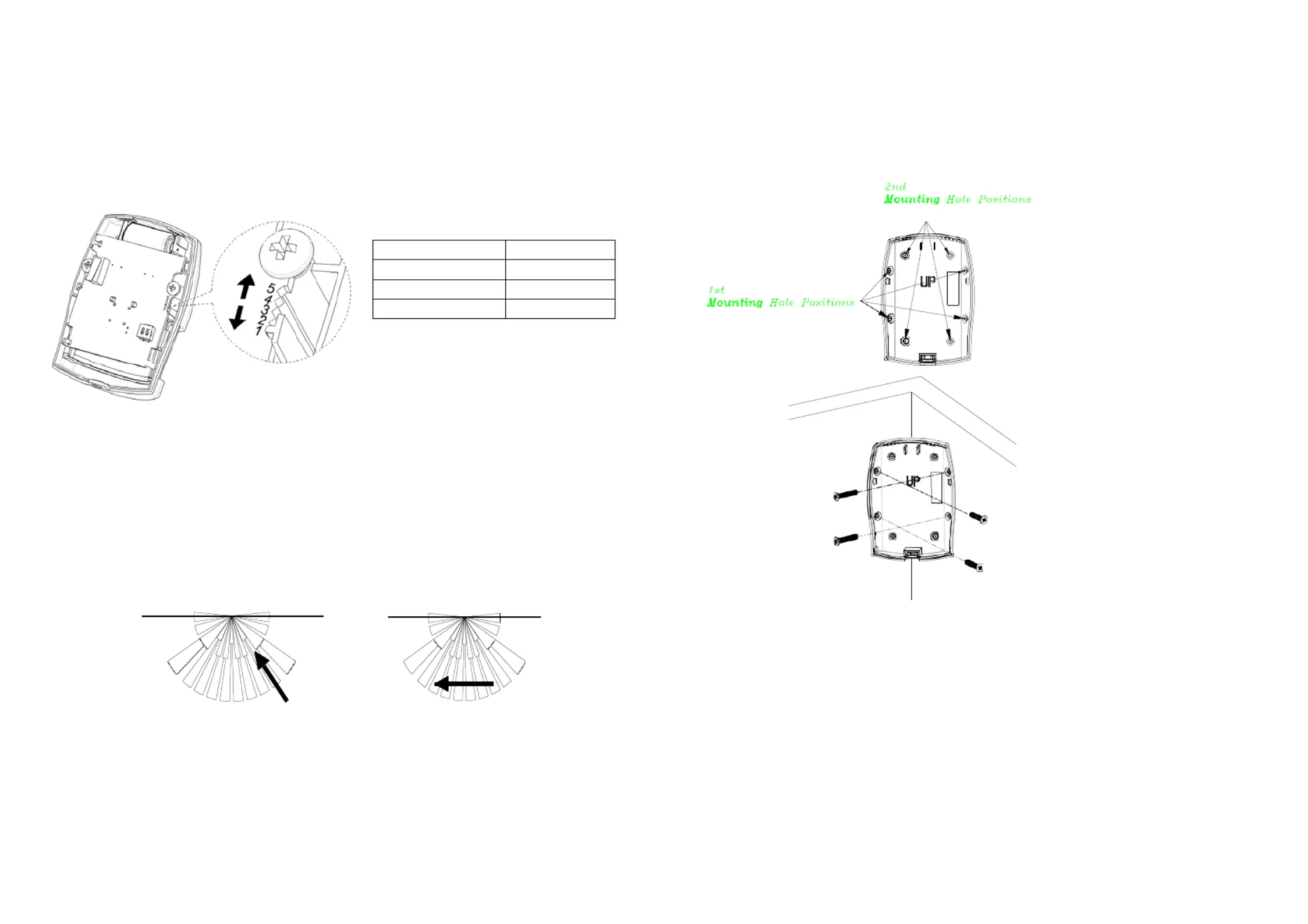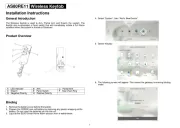Elro AS80PR11 Handleiding
Elro
Beveiliging
AS80PR11
Bekijk gratis de handleiding van Elro AS80PR11 (4 pagina’s), behorend tot de categorie Beveiliging. Deze gids werd als nuttig beoordeeld door 55 mensen en kreeg gemiddeld 4.6 sterren uit 28 reviews. Heb je een vraag over Elro AS80PR11 of wil je andere gebruikers van dit product iets vragen? Stel een vraag
Pagina 1/4

1
AS80PR11
PIR Motion Detector
Installation Instructions
General Introduction
This Detector is designed with a Passive Infra Red (PIR) sensor and light sensor in -
order to fulfill the purpose of security and home automation. It detects motion by
monitoring changes in infra red radiation levels emitted by body heat.-
2.
Prepare a CR123A battery. Do not insert the battery into the unit yet.
3.
Log into the ELRO Smart Home Alarm account from a web browser.
4.
Select “System” then “Add a Device”.
Product Overview
LED
(hidden
behind
PIR lens)
LED Indication
PIR Lens
Tamper Switch
/ Link Key
Battery
Fixing Screw
5.
Select “PIR Detector”.
Red LED
Used to indicate trigger events, low battery power, and warm up
Green LED
Used to indicate key learning controls
Orange LED
Used to indicate no codes learned
Binding
1. Undo and remove the fixing screw from the bottom of the detector. Carefully
pull the bottom of the detector away from the rear cover and then slide down to
release the top clips.
6.
The following screen will appear. This means the gateway is entering binding
mode.

2
7.
At this for point, insert the battery with correct polarity into the unit.
8.
The screen below will appear in 10 seconds if the process is successful.
9.
Time-out will occur if the binding process was unsuccessful. Please refer to the
“Manual binding” section.
Note: Leave the detector with the rear cover open to prepare for testing.
Manual Binding
1.
Repeat steps 3 to 6 of the Binding with Homesys section.
2.
With the battery inserted, press and hold the link key on the PCB for 3 or more
seconds, and the detector start LED will to flash, that has entered implying it ID
code learning mode.
Link key /
Tamper
3.
The indicator stop flashing and LED will turn off within 5 seconds, indicating the
learning procedure is completed. The screen below will appear indicating the
process is successful.
4.
If after 30 seconds the LED flashes rapidly (with an interval of 0.1 second) for 3
times, it means the PIR failed the binding process.
Operation & Testing
Warm- Up
It will take approximately 2 minutes to warm up the Detector after a battery is
inserted. During this period the LED will flash red slowly. When the LED turns red
for 5 secon up procedure is complete and the detector is ready ds, it implies warm-
for detection.
Testing
1.
Go to System, and set it to ARM.
2.
Wait for 30 secs then wave your hand in front of the detector.
3.
If the test is successful the system will trigger an alarm (alarms are listed in
“Events”).
Note: It is necessary that the gateway is powered and connected to internet.
4.
If the test is unsuccessful, please check the troubleshooting section.

3
Mounting
The PIR Detector is suitable for mounting in dry interior locations only.
The recommended position for Detector corner of room mounted at a PIR is in the a
a height between 1.8 and 2m. At this height, the detector will have a maximum
range of up to 10m with a field of view of 110 and the position of the PCB set at° 5.
The position of the PCB inside the PIR can be set to 5 different positions to adjust
the range of the detector. Setting the PCB in position 3 will reduce the range to
approximately 6m, with position 1 providing a range of approximately 3m. The
recommended position for the PCB is position 5.
When considering and deciding upon the mounting position for the detector, the
following points should be considered to ensure a trouble free operation:
1.
Do not install the detector facing a window, exposed to or facing direct sunlight.
PIR Detectors are not suitable for use in conservatories.
2.
Do not install the detector exposed to ventilators or above a heat source (e.g.
fire, radiators, boilers)
3.
Where possible, mount the detector in the corner of the room so that the path of
an intruder would cut across the fan detection pattern. PIR detectors respond
more effectively to movement across the device than to movement directly
towards it.
Less Sensitive More Sensitive
5.
Do not install the detector in a position where it is subject to excessive vibration.
6.
Ensure that the position selected for the PIR Detector is within effective range of
the system (please refer to the Troubleshooting section).
Note: When the system is armed, household pets should not be allowed an into
area protected by a PIR Detector as their movement would trigger the PIR and
generate an alarm.
Installation
1. Using a 3mm drill, carefully drill out the required mounting holes in the rear
cover according to whether the unit is being mounted in a corner or against a
flat wall.
Note: Drill 1
st
mounting hole positions to fulfill corner mounting installation, and
2
nd
mounting hole positions for flat wall installation.
Corner mounting
3.
Using the rear cover as a template, mark the positions of the fixing holes on the
wall.
4.
Fix the rear cover to the wall using the two 18mm No.4 screws and 25mm wall
plugs (a 5mm hole will be required for the wall plugs). Do not over tighten the -
fixing screws as this may distort or damage the cover.
5.
Check that detector located and set correct the PCB is in the position to provide
the required detection range. To adjust the PCB position, simply slide it up or
down ensuring that the location legs are aligned with the required position
number marked on the board.
6.
Refit the detector to the rear cover and locate the clips in the top edge into the
rear cover. Push the lower edge of the detector into place and refit the fixing
screw in the bottom edge of the detector to secure in position. Do not over-
tighten the fixin damage theg screws as this may casing.
PCB Position
Range
1
3m
3
6m
5
9m
Product specificaties
| Merk: | Elro |
| Categorie: | Beveiliging |
| Model: | AS80PR11 |
Heb je hulp nodig?
Als je hulp nodig hebt met Elro AS80PR11 stel dan hieronder een vraag en andere gebruikers zullen je antwoorden
Handleiding Beveiliging Elro

2 Februari 2023

2 Februari 2023

2 Februari 2023

2 Februari 2023

2 Februari 2023

2 Februari 2023

2 Februari 2023

2 Februari 2023

2 Februari 2023

2 Februari 2023
Handleiding Beveiliging
- Eufy
- Lamax
- Unitron
- Smartwares
- Powerfix
- Indexa
- Elkron
- Xavax
- Velbus
- BML
- Honeywell
- Tegui
- Trebs
- Jacob Jensen
- Ksenia
Nieuwste handleidingen voor Beveiliging

6 Maart 2024

4 Februari 2024

16 Oktober 2023

16 Oktober 2023

16 Oktober 2023

16 Oktober 2023

16 Oktober 2023

16 Oktober 2023

16 Oktober 2023

16 Oktober 2023